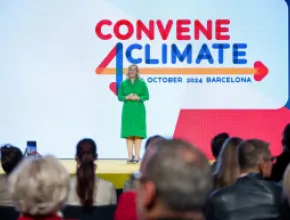Getting started can be the most intimidating part—we here at Meeting Strategies Worldwide hear it a lot—but not if you look at it this way: You’re going to choose a venue, order food and beverage, and invite people. You may also choose an exhibit decorator, transportation company and hotel accommodations. These probably require a request for proposal, site inspection and a contract. You do all those things daily. Right?
Now do the exact same things through the green “filter.” Add a few questions to the RFP about the venue’s environmental policies; ask the caterer for a sustainable menu; invite attendees electronically instead of on a printed document. There’s no need to reinvent the wheel—just make sure it treads lightly.
Start by understanding how greening your events will fit into your organization’s mission and values.
Following are some fundamental questions to ask when leading your organization’s stakeholders through the goals and objectives for green meetings:
Why does the organization want to incorporate green practices?
This question may seem self-explanatory, but ask it anyway. The answers received may be different than expected, and will shape the approach you take. For example, is the reason member-driven? Is it part of the mission statement? Is the CEO asking for it to be green? Are there external influences impacting the organization’s image?
How much is the organization willing to contribute?
Is the organization willing to commit financially, or with time, if necessary, to support green event practices? Though many green practices produce cost savings, the decision to serve organic food, for example, may cost more.
It is extremely helpful to know if the organization is willing to spend more resources if some of the green practices recommended cost more than traditional practices or may take some time to research. It will be easy to show a budget of cost savings versus expenditures for green practices.
Is this a one-time effort, or part of the organization’s core practices?
This question clarifies the company’s long-term commitment and purpose for adopting greening practices. You can build on any level of commitment. If the intention is to green all future events, the learning curve for the first one should make it easier the next time. If this is a one-time effort, you should caution the organization that greening an event is most successful if you build on the successes of each event. Once the expectation has been established, participants will be enthusiastic about future efforts.
What components of the event do they see as the most important to green?
The answer to this question will provide direction and focus on where to spend time and resources. Showing success in an area that is considered important—for whatever reason—may lead to greater support in the future.
For example, is it to have recycling in the meeting venue? Is it to offer organic, local food and china service? Is it reducing paper by not sending out a four-color, multipage brochure? Or perhaps provide a carbon offset program for attendees’ travel?
These questions will get you started. You’re the event professional; stakeholders will look to you for both ideas and direction!
Once your organization has established the level of commitment to green the events, work to build on this by developing a green strategy for all of the organization’s meetings.
It’s easier to get financial and management support if you develop a greening plan with clear goals, as it will show how you will deploy environmental practices.
Sometimes the best way to enroll and engage the organization is to start with one or two new practices, with the intention of building on their success.
Use the following business case: the economic, environmental, competitive advantage, and potential for regulation to influence organizations, clients or sponsors. Explain how implementing green events can cause them and their organization to be viewed as leaders.
Setting the Standards
The next step is to develop minimum guidelines to incorporate in all events. The easiest way to get started is to use the Convention Industry Council’s Green Meetings Report. It offers helpful guidelines in eight areas of planning:
• Destination selection
• Accommodations selection
• Meeting and venue selection
• Transportation selection
• Food and beverage selection
• Exhibition production
• Communications and marketing
• On-site office procedures
Begin by choosing just one practice per category, if that feels more comfortable. Or choose several practices for one and fewer for another; it’s up to you.
We always begin by choosing what we call the “low-hanging fruit,” choosing the easiest and most rewarding first. Some conferences have extensive minimum guidelines, and some have fewer than 10.
No event is 100 percent green, but each small step makes a significant difference.
Establishing minimum guidelines for green events will also help you measure the progress of greening events. Use the guidelines as a deciding factor in selecting vendors. Be sure to let suppliers who were not selected know why they were not selected.
Communicating Objectives
Communicate expectations for the event very clearly, especially if greening practices are new. Communicate with your own organization first. Let them know what policies or new practices are being put into place to green the event, why they are important, and the plan to implement them. Clear communication establishes expectations and helps to enroll stakeholders in the process.
It’s important that your guidelines are part of any initial conversations with destinations, CVBs, vendors, etc. Remember to include the guidelines in the RFP stage of planning. This will make negotiating and implementing the practices much easier.
Make sure to inform participants. They will be more engaged in the greening efforts if the what, why and how are communicated to them. Let them know why the organization is doing things differently, and why it is important to make a change. Participants do not usually respond well to surprises, but are usually open to new practices and ideas if they are explained well.
Informing the media about greening efforts could offer a press-worthy angle to the meeting. The press—and, in fact, the entire meetings industry—is clamoring for measurable results from greening. Tell them!
Negotiating Green Practices
The negotiation phase incorporates green components as well. Know what practices your organization are willing to compromise on and which ones they are not.
Be aware of which practices are easily implemented and are cost-saving or cost-neutral for the vendor. Use the cost savings as leverage in negotiations.
The crucial component to remember when negotiating green efforts is to ensure they are included in your contracts.
Make sure to include an environmental clause in the contract, with measurable results and consequences for non-performance. Alternatively, offer an incentive for complying with the agreed-upon green practices.
Using Resources
Many resources are now available that provide sources for products and services, information about best practices, and opportunities to network with other industry professionals. Do you want to list any here?
When starting research on a new city, ask the CVB for a list of environmentally responsible vendors, including meeting venues and hotels.
Taking Your First Step
Now that you have some simple steps, the key to getting started is to just start. Don’t think of green meeting practices as another thing to add to a to-do list. Rather, incorporate the practices into the planning processes you already use. Even if you’re only able to implement one environmentally responsible practice, you will have made a difference.
In each column I write throughout the year, I will walk you through all of the event planning categories and discuss potential green practices in more detail, with tips on how to incorporate them.
Stay tuned!





